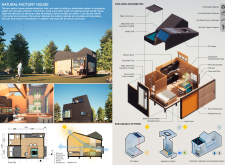5 key facts about this project
The overall structure features a modern design that includes both flat and sloped roofs, allowing for effective rainwater collection and optimal placement of solar panels. The layout promotes open living spaces that encourage interaction among residents while maximizing the flow of natural light and air. Key areas in the house consist of a central multifunctional hub, an efficiently designed kitchen, and individual spaces for relaxation and storage that ensure comfort and utility.
Sustainable features comprise a photovoltaic system for electricity generation, a rainwater harvesting system, and an aquaponic system that combines fish farming with plant cultivation, creating a closed-loop ecosystem. These elements work together to support the self-sufficiency of the residence.
Design Integration and Unique Features
What differentiates the Natural Factory House from conventional designs is its complete emphasis on sustainability and resource efficiency. The use of materials such as metal sheets with Galvalume coating, plywood with foam insulation, and transparent polycarbonate panels allows for durability and effective thermal performance while minimizing maintenance costs. The architectural design prioritizes long-term resilience and adaptability over short-term aesthetics.
Additionally, the incorporation of outdoor living spaces and greenery enhances biodiversity and provides a visual connection with the natural environment. The integration of smart home technologies further improves energy management, ensuring that the house operates efficiently while adapting to the occupants' needs.
Functional Systems and Space Utilization
The architectural plans reflect a meticulous approach to space utilization, ensuring that every area serves a purpose without excess. The juxtaposition of indoor and outdoor spaces fosters a seamless transition between living areas and nature. Systems such as the aquaponic setup not only contribute to food production but also enhance the quality of life by reducing waste and promoting self-sufficiency.
The attention to detail in the architectural sections highlights how the design accommodates both function and form, allowing residents to engage with their environment meaningfully. The proposed solutions present practical applications of environmentally conscious practices that can influence future architectural ideas.
For further insights into the architectural designs and functionality of the Natural Factory House, exploring the architectural plans and sections will provide a comprehensive understanding of its innovative approach and unique characteristics.























